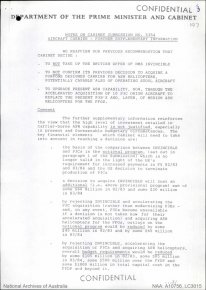So back to @StingrayOZ 's comment about hardpoints - we pretty much have. With F-35 internal only we've come close to halving the number of F-111 and F/A-18A+ hardpoints.
I don't want to get too far down this rabbit hole, as it was a bit of a throw away comment. Getting in to the mindset of a Shackleton...
Internal hard points.. That is a specific way of looking at it.
AFAIK
F-18 had 9 hardpoints. x 72
F-111 had 9 hard points (2 internal) x 12
The F-35 has 10. (4 internal) x 72
The F-18SH has 11 x 12 (leaving growlers out)
While not all hardpoints are equal (a Sidewinder isn't the same as a 2000lb jdam), and not all planes are equal, it would seem the RAAF is doing "ok". Its not like the F-18s were replaced with Hawks which have only 5 hardpoint and are lesser platforms in size, range, capability. The drama that was unleashed when the decommissioned the F-111's was like the world was coming to an end. To this day there are people who want to dig up those cut up frames, weld them together, and re-engine them and put them back to cover the "capability gap". (despite the P8 with LRASM being a much better platform here today). Im not arguing the reduction of the RAAF, but that broadly, some metrics should keep broadly simular.
Certainly big dumb metrics isn't the point. But with Dutton saying war is absolutely imminent and its like the 1930's, lets say he is perfectly right. We are probably less prepared for a peer conflict than we were in any period in the last 70 years.
If we wanted a modern equivalent of what we had for a surface force back in 1994 it would be more like 3 Burkes, 6 Hobarts, 3 Anzacs. 3x96=288, 6x48=288, 3x8=24. 600 even.
What is the bet in 3 years time the RAN looks like ~7 Anzac's, 1 in upgrade, 1 hobart, 2 in upgrade, 1 Hunter still in construction. 104... A Tico would carry more than the entire fleet.
So when people like Shackleton start jumping up and down, they are worried that in 3 years time we have a force in broad dumb terms perhaps of the order of 6 times less capable than it should be for a high intensity peer conflict.
Now ESSM is a great missile, and SM-1 an average. But China isn't making smaller ships. Threats aren't decreasing, munitions are getting smarter, longer ranged and more evasive. In peace time, or against asymmetric threats where you will only be firing a few missiles capability of quantity stands strong.
But SHTF all out peer US/China war? Even if we just fill them with ESSM, and they were magical and could take on all threats, ships, land strike, planes, missiles, and quad packed them, we are still probably 50% short in this big dumb metric comparison. Welding a few extra cells to a Anzac/Hunter/Hobart isn't going to solve this kind of gulf. VLS cells themselves are getting bigger, divide our cells by ~3 for hypersonics. A 32 cell launcher on Hunter becomes a 12 cell launcher.
We certainly can't count on the US saving Australia either. There are no cruisers, they are all gone, essentially confined to port. The early burkes are also on the way out, and those 5 years the US forgot to build any surface ships, built LCS's and Zumwalts. The back log for repairs, refits for surface and submarines means the US will be flat our mustering enough for CBG duties alone (and there is less of those and less availability too).
I'm not sure building burkes is the solution, there would have to be more discussions about that. But I also don't think we should get too flustered if we built 3 more Hobart's like its going to break the RAN's/ADF/AU back. Even as a 20 year temporary measure so Anzacs isn't serving into the 2040's or 2050's. The US isn't flooding the 2nd hand ship market anymore with WW2 specials. World will be hungry for ships, just like we see Ukraine is hungry for everything.
Due to project slippage, dithering and escalation of threats, IMO Australia should probably look at having two full surface ship production lines. That can address our current problems in surface combatants ships, and be adapted to help support the sub program when that gets back into action.

